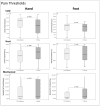Patients with sickle cell disease have increased sensitivity to cold and heat
- PMID: 23115062
- PMCID: PMC3552380
- DOI: 10.1002/ajh.23341
Patients with sickle cell disease have increased sensitivity to cold and heat
Abstract
Sickle cell disease (SCD) pain is associated with colder temperatures and touch and described as "cold," "hot," and "shooting" suggesting hypersensitivity to tactile stimuli. Sickle mice exhibit hypersensitivity to thermal (cold, heat) and mechanical stimuli compared to controls. It is unknown whether humans experience this same hypersensitivity. Thus, we quantified thermal and mechanical sensitivity differences between patients with SCD and controls. Our primary hypothesis was that patients with SCD will exhibit hypersensitivity to thermal and mechanical stimuli compared to race-matched controls. Our secondary hypothesis was this hypersensitivity will be associated with older and female subjects, and with frequent pain and hemolysis in patients with SCD. A total of 55 patients and 57 controls ≥7 years completed quantitative sensory testing. Patients with SCD detected the sensation of cold and warm temperatures sooner as seen in their significantly lower median cold and heat detection thresholds [29.5°C vs. 28.6°C, P = 0.012 and 34.5°C vs. 35.3°C, P = 0.02] and experienced cold and heat pain sooner as seen in their significantly lower median cold and heat pain thresholds [21.1°C vs. 14.8°C, P = 0.01 and 42.7°C vs. 45.2°C, P = 0.04]. We found no mechanical threshold differences. Older age was associated with lower cold, heat, and mechanical pain thresholds in both groups. No association with pain, gender, or hemolysis was found. Patients with SCD exhibit hypersensitivity to thermal stimuli suggesting peripheral or central sensitization may exist and could contribute to SCD pain.
Copyright © 2012 Wiley Periodicals, Inc.
Conflict of interest statement
The authors declare no competing financial interests.
Figures


References
-
- Platt OS, Thorington BD, Brambilla DJ, et al. Pain in sickle cell disease. Rates and risk factors. N Engl J Med. 1991;325:11–16. - PubMed
-
- Smith WR, Penberthy LT, Bovbjerg VE, et al. Daily assessment of pain in adults with sickle cell disease. Ann Intern Med. 2008;148:94–101. - PubMed
-
- Panepinto JA, Brousseau DC, Hillery CA, et al. Variation in hospitalizations and hospital length of stay in children with vaso-occlusive crises in sickle cell disease. Pediatr Blood Cancer. 2005;44:182–186. - PubMed
-
- Smith WR, Bauserman RL, Ballas SK, et al. Climatic and geographic temporal patterns of pain in the Multicenter Study of Hydroxyurea. Pain. 2009;146:91–98. - PubMed
Publication types
MeSH terms
Grants and funding
LinkOut - more resources
Full Text Sources
Medical
